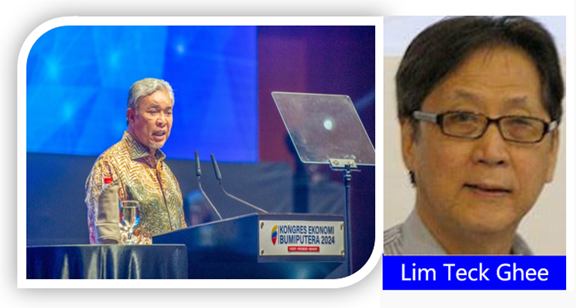林德宜<东方网>专栏评论:
"昌明土著经济大会"
是"新瓶装旧酒"吧?
这是作者针对团结政府的土著经济大会在《东方网》专栏,继上周的《安华能否重塑土著议程?》(Can PMX Reinvent the Bumiputera Construct?)一文之后发表的第二篇评论。全文如下(上图和文内小标题为《人民之友》编者所加)——
当我们看到马来领袖站出来,认同土著经济大会也应关注和探讨非土著面对的问题时,这是令人鼓舞的。依据巫统总秘书长阿斯拉夫说法,讨论提升土著权利并不会否定非土著权利,政府的目标是专注于制定有效战略,以强化其提升大多数人口,即土著议程的制定,从而“提升土著的尊严”。
由于许多参与者在1970年时还没出世,因此重新审视激发土著和非土著政策建构的新经济政策(NEP)目标,可以更好地评估这两方面所取得的进展。其还可以为国家领袖和政策制定者提供建议,在提高所有马来西亚人的“尊严”和福祉时,应重点关注的问题。
当年在大马远景计划1(1971-1990年)下设定了四个关键目标。这些领域在1970年土著份额为:
贫穷率 - 65%股权(公司)- 2.4%土著就业(按学历划分)小学 - 66.2%中学 - 12.1%大专 - 21.7%土著就业(依职业)注册专业人士 - 29%
自此,政府官员和独立研究人员——土著和其他马来西亚人——一致认同社会结构重组目标已经实现。毫无疑问,新经济政策帮助土著社会的马来人实现了1970年设定的种族重组目标。事实上,马来人在一些关键领域,例如官联公司占主导地位的领域,取得了超额的成就。
受到较少关注,但更令人重视的政治和政策目标,即增加马来人,而不是整体土著,在高薪专业、技术、行政和管理职位中的份额。
NEP造就马来专业人员极大成功
为此,政府制定了一些重要政策措施和动用了纳税人钱,以提升马来人在一些理想职业中的占比——建筑师、会计师、医生、牙医、律师、测量师、兽医和工程师。新经济政策的这一部分取得了巨大成功。
1970年,土著从事这些职业的比例只有4.9%。相比之下,华裔的占比为61%,印裔为23.3%,其他族群为10.8%。
到了1990年新经济政策结束时,土著的比例已增加至29%。华裔占比为55.9%,印裔则是13.2%,其他族群为1.9%
如今,根据最新官方统计数据,在57万6412名注册专业人士中,土著人数为23万8853人(参见统计局于2023年12月19日发布的2023年土著统计数据)。土著专业人士中,马来人的比例可能高达90%或更高。
纵观过往纪录,土著议程建构注重于培养马来专业人才、高等教育毕业生数量以及公私部门就业提升下带动起来的马来中上阶层,这也是马来社会发展的动力。
这种种族倾向的发展速度和强度,在世界上是前所未见的。
这次大会应该讨论几个关键问题
这股在社会和经济重组中崛起的阶层,其能力和资源,能否在没有优惠政策下,为国家做出更大的贡献,这应该是本次大会讨论的一个关键议题。
另一个同样重要的主题是非马来土著相关的课题。非马来土著能否从社会与经济的种族重组结构中受益?
半岛原住民以及沙巴和砂拉越土著的一些领导人,尽管个人在土著政策下受益,但也一直对亲土著政策持批评态度。他们认为,现有土著政策下,他们只是门面装饰。他们日趋不满,尤其他们的族群无法得到犹如半岛马来人所享有的福利和援助。
他们是否有实例?如果有,可以采取哪些措施来确保有弹性、可持续且代价较低的成果?
为了便于讨论,有必要在目前的统计资料和政策评估下,划分出三个目前不存在的类别:即马来土著、沙巴土著和砂拉越土著。这种精细的分类讨论,是关心公平竞争和社会正义的土著大会参与者不能缺失的。
大会须检讨土著特权的滥用状况
最后但同样重要的是,在土著经济大会中,应对土著特权的滥用,尤其从政策一开始落实之时,就出现的滥用情况进行讨论。土著特权滥用已屡见不鲜。
每当规则被当局扭曲时,自肥、机会主义、剥削、滥用的结果将是不可避免的。当建立两种或多种特权和权利时,严重的违规和不道德行为也将随之而来。
毫不惊讶,对于那些走捷径、插队、如从事贿赂、腐败和不诚实交易等不道德行为的人来说,特权队列中的回报是呈几何级数增长;甚至简单地透过使用地位、知道谁或如何,以及其他不那么可疑但依然合理的手段,也可取得权势和累积财富。
特权者劫取数千亿甚至数兆财富
著名学者奥扎伊罕默在1986年出版,之后于2011年重新再版的一本具有里程碑意义的著作《马来西亚的发展:贫穷、财富与托管》一书中指出,以下群体透过共谋、交易和其他非竞争形式,成为新经济政策和土著托管制下的主要受益者:
政治
官僚
军队
宗教
罕默在结论中指出:
这种制度的动态和结构,促进了一种非竞争体系,其中得利最大者是那些以权力进行勾结、以权谋私和寻租的人。
这群人透过合法和非合法手段在体制占据主导地位,并依然发挥作用。进而,劫取了国家财库的数千亿,甚至可能是数兆财富。
罕默的研究主要是在政治经济领域。但这模式依然可适用于社会其他方面,只要有特权的机制,精英或特定群体就可能以受托人和掌管者身份上下其手。
马来社会近来对特权分配出现争议
近来,马来社会也对特权分配出现了争议,即富裕有权势的家庭孩子,获得玛拉初级学院学位,剥夺了贫困家庭孩子的利益,这进一步凸显了改革马来西亚特权机制的必要。土著经济大会能否确保那些最需要、最值得、最有能力、最有成就的人,才是应获得政府在社会经济领域提供的一切资助——无论是扶贫、教育奖学金、大学学位、公务员职位等。
这又是否可以透过开放、完全透明和负责任的系统,使其适用于马来人和非马来人、土著和非土著。■
林德宜《昌明土著经济大会:新瓶旧酒?》原文:
Madani Bumiputera Economic
Congress: Same Old Stuff?
By Lim Teck Ghee
It is encouraging to see Malay leaders come out to support the inclusion of
non-bumiputera issues and concerns at the coming Bumiputera economic congress.
According to UMNO secretary general Asyraf Wajdi Dusuki discussing the
elevation of bumiputera rights does not negate non-bumiputera rights with the
government objective to focus on effectively strategizing to empower its
agenda for the majority of the population thus “elevating its dignity”.
As many participants will not have been born in 1970, a revisit of the New
Economic Policy (NEP) objectives that inspired the bumiputera and non
bumiputera policy construct can provide a better assessment of the progress
made on these two fronts. It can also provide ideas on what next the nation’s
politicians and policy makers should focus on to elevate the “dignity” and
well being of all Malaysians
Four key targets were set for the country under OPP 1. These targets with the
bumiputera share in 1970 were
Incidence of poverty - 65%
Ownership of equity (corporate) - 2.4%
Bumiputera employment by sector
Primary - 66.2%
Secondary - 12.1%
Tertiary - 21.7%
Bumiputera employment by occupation
Membership of registered professionals - 29%
Since then government officials and independent researchers - Bumiputera and
other Malaysians - agree that the racial restructuring targets for the
different sectors have been achieved. There is no dispute that the NEP has
helped the Malay component of the Bumiputera community attain the racial
restructuring targets set in 1970. In fact Malays have overachieved in some
key sectors such as those in which the GLCs dominate.
Receiving less attention but an even more coveted political and policy target
has been to increase the Malay - though not the Bumiputera - share of high
paying professional, technical, administrative and managerial positions.
Some of the most important policy initiatives and taxpayers monies have gone
to support the increase in the Malay share of desirable professions -
architects, accountants, doctors, dentists, lawyers, surveyors, veterinary
surgeons and engineers. This part of the NEP has had great success.
In 1970, Bumiputera share of these professions stood at 4.9%. In contrast
Chinese share was 61%, Indian 23.3% and Other at 10.8%.
By 1990 at the end of the NEP, Bumiputera share had increased to 29%. Chinese
share was 55.9%, Indian share 13.2% and Other, 1.9%
Today, according to the latest official statistics, Bumiputeras number
238,853 of the 576,412 members of registered professions - (see Department of
Statistics, Bumiputera Statistics 2023; released on 19 December 2023).
The Malay share of Bumiputera professionals is likely to be as high as 90% or
more.
Learning from the Past
Looking at the past record, the Bumiputera construct with its emphasis on
Malay professional manpower, higher education graduates and the growth of the
Malay middle and upper class spurred by employment in both public and private
sectors has been the driving force for the Malay community’s
development.
It is a development quite unprecedented in its speed and intensity amongst
racially favoured communities in the world.
Whether the abilities and resources of this newly arrived significant
component of society and economy can be used for the larger national interest
without favouring it with preferential policies should be a key subject in the
Congress discussion.
An equally important subject is that related to other indigenous communities -
that is the non-Malay component of the Bumiputera grouping. Can non-Malay
indigenous natives benefit from racial restructuring of society and
economy.
Some leaders from the Orang Asli community in the Peninsula and Orang Asal
from Sabah and Sarawak - despite having personally benefited - have been
critical of the implementation of pro Bumiputera policies. They argue that
inclusion of their communities in the Bumiputera construct has been for window
dressing. There is increasing resentment that their marginalised communities
have been excluded from the perks and assistance that Peninsular Malays have
benefited from.
Do they have a case and if yes, what can be done to ensure resilient,
sustainable and less expensive outcomes?
To facilitate this discussion, it will be necessary to separate the current
statistical data base and policy assessments into the three, for now, absent
categories of Bumiputera Malay and Bumiputera Orang Asal Sabah and Bumiputera
Orang Asal Sarawak. This refined classification is the missing component that
participants in the Congress who are concerned about fair play and social
justice will need to make their case.
Trusteeship Capturing the Spoils of Bumiputerism
Last but not least in importance in the forthcoming Congress discussion is the
fact that abuse of Bumiputera privilege began as soon as the policy came into
effect. This should be no surprise.
Self enriching, opportunistic, exploitative, abusive outcomes are inevitable
any time a queue is established and the rules of the game are skewed by the
queue authorities. Greater irregularities and unscrupulous practices can be
expected when two or more queues of privilege and entitlement are established.
Unsurprisingly too, the rewards in a privileged queue will increase in
geometric progression for those willing to cut corners, jump the queue, engage
in unscrupulous practice including bribery, corruption and dishonest dealings;
or even simply through using status, know who or how-ism and other less dodgy
but still justified as in line and acceptable strategies of position
advancement and wealth acquisition.
Ozay Mehmet in a landmark book published in 1986 and subsequently republished
in 2011 as Development in Malaysia: Poverty, Wealth and Trusteeship,
identified the following groups as key beneficiaries of the NEP and Bumiputera
trusteeship through collusion, transaction costs and other non competitive
forms:
Political
Bureaucratic
Military
Religious
Mehmet’s conclusion:
The system’s very dynamics and structure promotes a non-competitive system in
which the greatest benefits accrue to those with power to exercise collusion,
influence peddling and rent seeking.
These groups and their dominance of the system through legal and less legal
means are still actively at work. Hence the hundreds of billions of ringgit,
possibly trillions, extracted or hijacked from our Treasury.
Mehmet’s findings related to the workings of the political economy. But it can
be seen to apply to other sectors of the society any time a queue is set up,
and where elite or other group capture is likely with the connivance of the
trustees and gatekeepers.
The recent controversy in the Malay community on the privileged access of the
children of well to do parents to highly sought for places in MARA junior
colleges at the expense of children from poorer families further puts the
spotlight on the need to reform the Malaysian trusteeship system. Can the
Congress help ensure that those in greatest need, the most deserving, the most
competent, the most accomplished are recipients of whatever is to be funded by
the government in the socio economy - whether this is in poverty alleviation,
educational scholarship, university places, civil service positions, etc.
And can this be made applicable to Malays and non-Malays, Bumiputera and
non-Bumiputera through open, fully transparent and accountable systems.
■






















0 comments:
Post a Comment